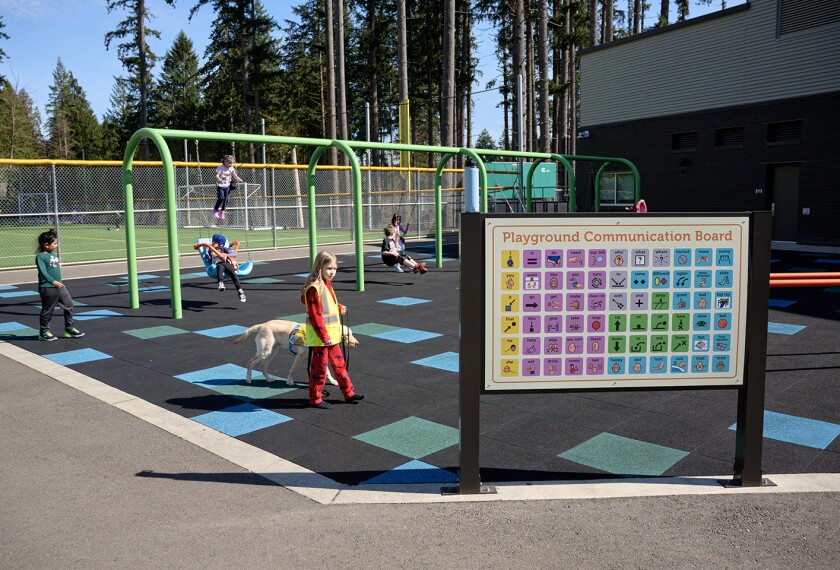Federal law requires states to provide “alternate assessments” for students with disabilities who cannot take regular state tests, even with accommodations. But the 1997 reauthorization of the Individuals with Disabilities Education Act provides few details about how such measures should look. The result is a wide variety of approaches.
In Massachusetts, about 5,000 students, or 1 percent of all those tested, submit portfolios for the Massachusetts Comprehensive Assessment System Alternate Assessment. Like many other states, Massachusetts has prepared an “expanded” version of its content standards that describes academic outcomes that are appropriate for students with significant disabilities in the areas of English/language arts, mathematics, science and technology, and history and social science.
To craft the portfolios, teachers identify specific outcomes for a student, based on the standards in each academic-content area being assessed. In math, for instance, the topics include number sense and operations; patterns, relations, and algebra; geometry; measurement; and data analysis, statistics, and probability.
Teachers then collect “evidence” of the student’s performance, ranging from work samples to audio- or videotapes collected during targeted instructional activities or structured student observations. Daniel Wiener, who oversees the alternate-assessment system for the state department of education, says the flexible system permits students and teachers to choose the “best way, best day, best work” evidence of what students know and can do, so that students are shown in the “best possible light.”
Trained teachers score the assessments in each content area. Scores range from “awareness,” meaning the student demonstrates very little understanding of the subject, to “advanced,” meaning the student shows a comprehensive and in-depth understanding of the subject at grade level. The top three performance levels parallel the top three levels on the regular state exam.
While teachers must submit at least three pieces of evidence for each topic area or “strand” assessed, portfolios often contain 65 or more pieces of material, reflecting both the students’ performance and their access to the general curriculum.
One of the biggest concerns with a portfolio system is time. In a letter to federal officials, Steven Stone, the pupil-personnel director at the Somerville Charter School in Somerville, Mass., wrote that “the burden of creating alternate assessments has led a number of special education directors to choose not to give the assessment to students.”
Weiner acknowledges, “People are not always happy with the amount of work involved in the portfolio, but I don’t know of any other way that would capture the breadth and depth of the standards.” Without the alternate assessment, which some students use to meet high school graduation requirements, he argues, “you don’t have a truly inclusive system.”
In contrast, Minnesota’s alternate assessment consists of rating scales, or checklists, completed by the child’s special education teacher based on the student’s ongoing work. A seven-point scale rates progress on a continuum from little or no ability in the area being measured to independent and consistent performance.
For students who are working primarily on “developmental academic skills,” teachers rate performance in reading, math, and writing. In reading, for instance, teachers can rate students in eight different areas, including pre-reading skills, decoding, fluency in silent reading, and literal comprehension. For students whose individualized education plans indicate they are working primarily on functional-living skills, teachers rate performance in such areas as home living, recreation and leisure, and social skills, plus a more general assessment of academics.
The form, which teachers can complete in five or 10 minutes, “simply is not a burden,” says Bill McMillan, a supervisor in Minnesota’s state office of special education policy. He says the state wanted to avoid a cumbersome process.
Colorado takes yet another approach, using performance tasks. Currently, the Colorado Student Assessment Program-Alternate is given in grades 3-10 in reading and writing, grades 5-10 in math, and in grade 8 in science. In grades where the state has not yet pilot-tested performance tasks, it is collecting a body of evidence based on the same standards.
As in Massachusetts, the assessment is designed to measure students’ emerging skills in areas related to the state content standards.
The alternate assessment consists of structured activities that students complete one-on-one with a teacher during a four- or five-week period each spring. In 4th grade reading, for instance, activities include listening to a story and answering questions for understanding, going to the library, reading with a teacher or peer, and creating or writing a story. The test measures how independently the student performs tasks, with the teacher gradually increasing the level of support as needed. A student’s performance is scored from Level I, meaning the student was unable to perform the activity even with support, to Level 5, meaning the student performed the activity without any help.
“You try to zero in on what the students can do on their own,” says Carolyn A. Haug, the former state director of assessment for Colorado.
The top three levels of performance on the alternate assessment are considered “proficient” for purposes of rating schools.
The Colorado tests are less burdensome than a portfolio system that is collected throughout the year, Haug says. And because students complete the same set of activities, it’s easier to compare their scores. But the exams have been time-consuming and expensive to develop, particularly given the small number of students who take them and the fact that tasks must be “refreshed” or changed periodically. Colorado is hoping to collaborate with other states to bring down the per-pupil expense.




